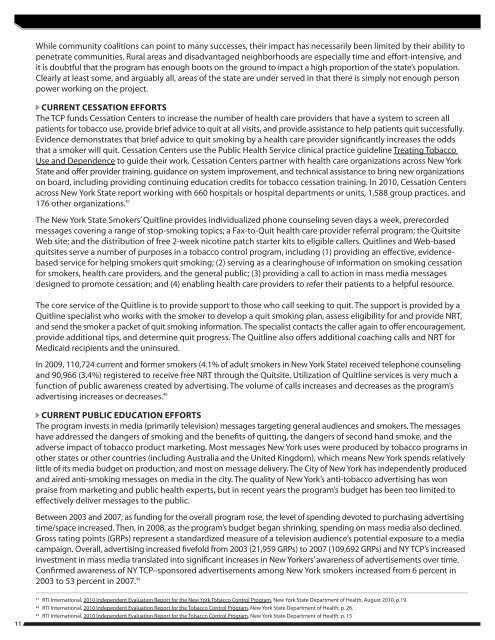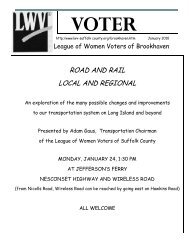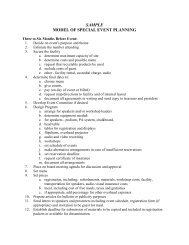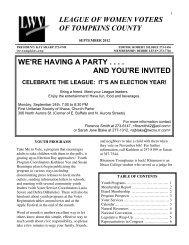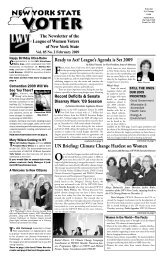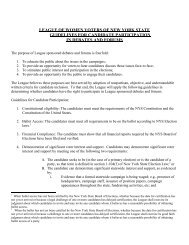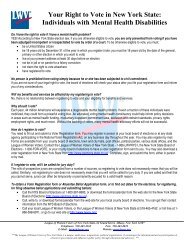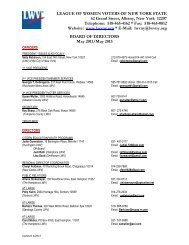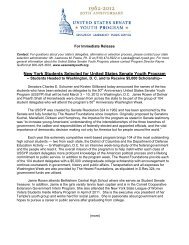UP IN SMOKE: - American Cancer Society
UP IN SMOKE: - American Cancer Society
UP IN SMOKE: - American Cancer Society
You also want an ePaper? Increase the reach of your titles
YUMPU automatically turns print PDFs into web optimized ePapers that Google loves.
11<br />
While community coalitions can point to many successes, their impact has necessarily been limited by their ability to<br />
penetrate communities. Rural areas and disadvantaged neighborhoods are especially time and effort-intensive, and<br />
it is doubtful that the program has enough boots on the ground to impact a high proportion of the state’s population.<br />
Clearly at least some, and arguably all, areas of the state are under served in that there is simply not enough person<br />
power working on the project.<br />
cUrrEnt cEssAtIon EFForts<br />
The TCP funds Cessation Centers to increase the number of health care providers that have a system to screen all<br />
patients for tobacco use, provide brief advice to quit at all visits, and provide assistance to help patients quit successfully.<br />
Evidence demonstrates that brief advice to quit smoking by a health care provider significantly increases the odds<br />
that a smoker will quit. Cessation Centers use the Public Health Service clinical practice guideline Treating Tobacco<br />
use and Dependence to guide their work. Cessation Centers partner with health care organizations across new York<br />
State and offer provider training, guidance on system improvement, and technical assistance to bring new organizations<br />
on board, including providing continuing education credits for tobacco cessation training. in 2010, Cessation Centers<br />
across new York State report working with 660 hospitals or hospital departments or units, 1,588 group practices, and<br />
176 other organizations. 47<br />
The new York State Smokers’ Quitline provides individualized phone counseling seven days a week, prerecorded<br />
messages covering a range of stop-smoking topics; a Fax-to-Quit health care provider referral program; the Quitsite<br />
Web site; and the distribution of free 2-week nicotine patch starter kits to eligible callers. Quitlines and Web-based<br />
quitsites serve a number of purposes in a tobacco control program, including (1) providing an effective, evidencebased<br />
service for helping smokers quit smoking; (2) serving as a clearinghouse of information on smoking cessation<br />
for smokers, health care providers, and the general public; (3) providing a call to action in mass media messages<br />
designed to promote cessation; and (4) enabling health care providers to refer their patients to a helpful resource.<br />
The core service of the Quitline is to provide support to those who call seeking to quit. The support is provided by a<br />
Quitline specialist who works with the smoker to develop a quit smoking plan, assess eligibility for and provide nRT,<br />
and send the smoker a packet of quit smoking information. The specialist contacts the caller again to offer encouragement,<br />
provide additional tips, and determine quit progress. The Quitline also offers additional coaching calls and nRT for<br />
Medicaid recipients and the uninsured.<br />
in 2009, 110,724 current and former smokers (4.1% of adult smokers in new York State) received telephone counseling<br />
and 90,966 (3.4%) registered to receive free nRT through the Quitsite. utilization of Quitline services is very much a<br />
function of public awareness created by advertising. The volume of calls increases and decreases as the program’s<br />
advertising increases or decreases. 48<br />
cUrrEnt PUblIc EdUcAtIon EFForts<br />
The program invests in media (primarily television) messages targeting general audiences and smokers. The messages<br />
have addressed the dangers of smoking and the benefits of quitting, the dangers of second hand smoke, and the<br />
adverse impact of tobacco product marketing. Most messages new York uses were produced by tobacco programs in<br />
other states or other countries (including Australia and the united Kingdom), which means new York spends relatively<br />
little of its media budget on production, and most on message delivery. The City of new York has independently produced<br />
and aired anti-smoking messages on media in the city. The quality of new York’s anti-tobacco advertising has won<br />
praise from marketing and public health experts, but in recent years the program’s budget has been too limited to<br />
effectively deliver messages to the public.<br />
Between 2003 and 2007, as funding for the overall program rose, the level of spending devoted to purchasing advertising<br />
time/space increased. Then, in 2008, as the program’s budget began shrinking, spending on mass media also declined.<br />
Gross rating points (GRPs) represent a standardized measure of a television audience’s potential exposure to a media<br />
campaign. overall, advertising increased fivefold from 2003 (21,959 GRPs) to 2007 (109,692 GRPs) and nY TCP’s increased<br />
investment in mass media translated into significant increases in new Yorkers’ awareness of advertisements over time.<br />
Confirmed awareness of nY TCP–sponsored advertisements among new York smokers increased from 6 percent in<br />
2003 to 53 percent in 2007. 49<br />
47 RTi international, 2010 independent Evaluation Report for the new York Tobacco Control Program, new York State Department of Health, August 2010, p.19.<br />
48 RTi international, 2010 independent Evaluation Report for the Tobacco Control Program, new York State Department of Health, p. 26.<br />
49 RTi international, 2010 independent Evaluation Report for the Tobacco Control Program, new York State Department of Health, p. 15


